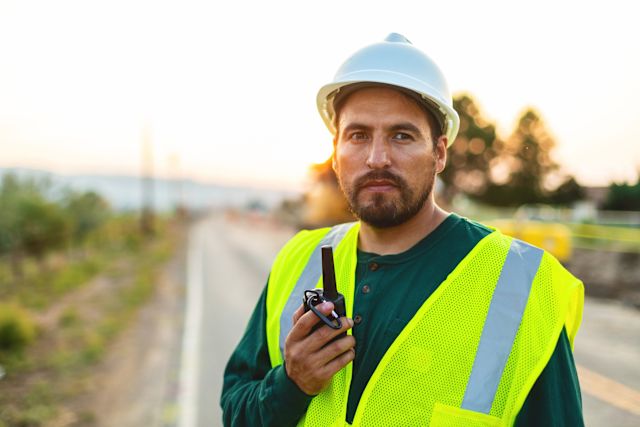Updated on September 27, 2024.
Air pollution contributes to more than 5 million deaths per year across the globe. In the United States, nearly 4 out of 10 people live in a place with poor air quality. While its links to physical conditions like asthma and lung cancer are widely known, many people aren’t aware of the ways air pollution can influence mental health.
In fact, rising pollution levels from smog, factories, gas-burning vehicles, and wildfires, among other factors, can have significant effects on an emotional level. The mental distress that people may experience as a result of climate change is known as “eco-anxiety.” Poor air quality is also linked to changes in behavior and moods, productivity at work, and general well-being.
Breathing in polluted air can also affect mental health through its influence on bodily processes. For instance, tiny particles inhaled from pollution may affect your hormones, immune system, and your brain chemistry. Air pollution is even linked to an increased risk of dementia over time.
Poor air quality can harm you, but it does not mean it inevitably will. Learn more about the connection between air pollution and mental health—plus steps you can take to protect yourself and others around you.
Extreme heat makes air pollution worse
The summer of 2024 was one of the hottest on record in the U.S. and around the world. As temperatures rise, air pollution tends to worsen, which in turn worsens air quality. Here’s how:
Heat contributes to ozone buildup
The air quality index (AQI) is a rough measure of air pollution. It’s measured on a scale of 0 to 500, with higher numbers indicating worse pollution. The scale reflects the total amount of dangerous particles, called particulate matter (PM), in the air. Particulate matter can come from many sources, including smoke from factories, wildfires, or car tailpipes. Air quality tends to be worse on hot days because heat increases the buildup of a gas called ozone at ground level.
Ozone is not always bad. When it is found in the upper atmosphere, it protects the earth from harmful ultraviolet (UV) rays from the sun. Ozone can be dangerous when it forms closer to the earth’s surface. This typically happens when UV radiation from the sun interacts with certain types of air pollution, such as from factories and cars.
Heat increases ozone. In turn, ozone can trap other air pollutants. Together, they may create a bad air “bubble” around places where people live. This bubble may increase the number of dangerous chemicals and gases people breathe on days when air quality is poor.
On its own, extreme heat can put you at risk for physical and mental health conditions. It can contribute to heat-related illnesses like heat stroke and can worsen existing mental health issues. Likewise, ground-level ozone is harmful to human health because it is dangerous to breathe. When you combine heat and ozone, their risks are magnified.
Heat can worsen wildfires
You may have noticed more and more stories in the news about wildfires—or experienced them firsthand. In fact, wildfire seasons have been starting earlier and ending later because of climate change and rising temperatures. Individual fires, meanwhile, have become harder to control.
Wildfires contribute to pollution by releasing substances (like ozone, lead, and particulate matter) into the air. Wind, clouds, and rain can move these substances across the U.S. and around the world, affecting people far away from fire sources. Many people in the U.S. experienced this in 2023 as a result of the wildfires that spread across vast swaths of Canada.
For people with ongoing health issues like asthma, bad air quality days from wildfires can create anxiety about going outside. Wildfire soot, which consists of tiny carbon particles that come from burning wood, can also enter people’s homes through windows, cracks, and vents. Once inside homes, these tiny particles can enter the body when breathed in.
The connection between stress and air pollution
Knowing that the air around you is polluted can make you feel fearful or anxious. Scientists suspect there may also be biological reasons why air pollution affects mental health.
Inflammation, for example, may be at the root of these issues.
Pollution increases inflammation
Inflammation is part of the body’s healthy response to injuries and infections. When you get sick, you may develop a fever; when you sprain your ankle, your skin may feel warm to the touch. But too much bodily inflammation over time can strain or damage your organs. Inflammation can also worsen or increase the risk of developing many mental health conditions.
Particulate matter can enter the lungs and the bloodstream and cause inflammation. These tiny particles can travel almost anywhere in the body, including to the front and core of the brain. There, they may contribute to a wide array of mental health issues, including anxiety and depression.
Pollution’s effects on brain chemicals and hormones
Neurotransmitters are chemicals that help brain cells communicate. When these chemicals are interrupted, our ability to respond to stress is affected, which may lead to mood changes. Some research suggests a link between air pollution and changes in the way neurotransmitters work.
Particulate matter can also disrupt hormones in the body. For example, it may cause levels of stress hormones like cortisol to rise. Having higher levels of stress hormones over time may increase the risk of depression and anxiety, as well as conditions such as high blood pressure and type 2 diabetes.
Some groups are at greater risk from air pollution
Certain communities are at greater risk of exposure to air pollution and the ill effects that come from it. These include populations located near major sources of pollution, such as highways, landfills, industrial facilities, and factory farms.
Because of the long history of racism and unjust policies and practices in the U.S., including segregation, sources of pollution are more likely to be situated in and around communities of color. As a result, people of color are more likely to experience mental and physical health effects from air pollution today. The combination of physical and mental stress from exposure to air pollution—combined with the stress of the lived experience of discrimination—can contribute to poorer health outcomes and lower life expectancy.
People who work outdoors or near or in polluting facilities also typically can’t choose to stay home on bad air quality days. As a result, they are often exposed to air pollution continuously over many years.
Other factors that increase the risks posed by air pollution include:
- Age and stage of life: Older adults, pregnant people, babies, and young children are especially vulnerable to the health effects of air pollution.
- Other health conditions: People with chronic health conditions like diabetes or asthma may be more vulnerable to the effects of air pollution.
How to protect yourself and loved ones
It might feel overwhelming to think about how air pollution affects us, says Kate Pfeiffer, DNP, CRNP, associate professor and psychiatric mental health nurse practitioner program director at Quinnipiac University School of Nursing in Hamden, Connecticut. But there are steps you can take every day to reduce your exposure to pollution outdoors and to improve the air quality in your home.
Check the air quality daily
Know the air quality index (AQI) before going outside by checking AirNow.gov or using the AirNow app from the U.S. Environmental Protection Agency (EPA):
- An AQI of 50 or less indicates a “good” air quality day. You can feel confident going outside.
- An AQI of 51 to 100 means the air quality is “moderate.” It can be risky to go outside if you have asthma or other lung or heart conditions.
- When the AQI reaches 101 or more (“bad” air quality), spend as little time outdoors as possible.
On most days, try to stay inside during the middle of the day when air pollution tends to be worst.
Remember your mask
If you have to go outside on bad air quality days, wear a high-quality surgical mask or an N95 mask to help filter the air you breathe. A surgical mask is a loose-fitting mask with ear loops that may have a metal nose bridge; it can help catch larger droplets or particles. An N95 mask is a tight-fitting mask that forms a seal around your mouth and nose; it will more effectively filter out larger droplets and most small particles.
You can find masks online and in most hardware stores. Check to see if they are approved by the National Institute for Occupational Safety and Health (NIOSH). (It should say so on the package.) Children, pregnant people, and older adults should be especially mindful about wearing masks when outside on bad air quality days.
Consider buying or making a portable air filter
If your home has a heating, ventilation, and cooling (HVAC) system, make sure it uses a high efficiency particulate air (HEPA) filter. Work with your HVAC company or read your HVAC guidelines to know how often to clean or change your HEPA filter to keep it working correctly.
If you don’t have an HVAC, an alternative is to use portable air purifiers that circulate the air in your home and remove indoor air pollution. Many store-bought options cost upwards of $100.
If you can’t afford a store-bought HEPA filter, you can make an air purifier at home using products available at most hardware stores and major retailers. Follow these tips from the Centers for Disease Control and Prevention (CDC) to build your own air purifier.
Avoid often-overlooked sources of indoor air pollution
We often think about outdoor air when we think about air pollution, but we spend 90 percent of our time indoors. Home appliances and items like wood-burning fireplaces, candles, and gas stoves can contribute to pollution.
While it may be hard to change your cooking habits, you can help keep inside air clean by running the kitchen vent fan (if you have one) while cooking, opening windows if the outdoor air quality is good, or using an air purifier.
Safeguard your mental health
If news about climate change or wildfires is causing you stress or you suspect that air pollution may be affecting your mental health, there are people and resources that can help. Across the U.S., people are forming support and volunteer groups to share their experiences confronting pollution—and to take action against climate change.
“We can offer support to others who are experiencing mental health symptoms that may have been brought on by air pollution,” says Pfeiffer. “We heal best when we are in community. We don’t have to get help alone.”
The Work That Reconnects, for example, is a network of support groups that focus on environmental healing using methods including group therapy, environmental workshops, and volunteering.
Talk therapy with a counselor can also help. There is a national alliance of counselors who focus on stress related to pollution and climate change called the Climate Psychology Alliance. You can use their online directory to find a therapist who understands the connections between stress and air pollution.
Other organizations that can help you access therapy include:
- Black Emotional and Mental Health Collective offers tools, wellness programs, a therapist directory, and mental health information and resources.
- Project Heal provides a directory of mental health resources for Black, Indigenous, and People of Color (BIPOC) individuals.
- Open Path Psychotherapy Collective connects users to low-cost therapy with clinicians from a variety of backgrounds.
- The Substance Abuse and Mental Health Services Administration (SAMSHA) can provide access to therapy or the resources to pay for counseling. Their national helpline is available 24/7, with phone, text, and TTY options (for people with speech or hearing impairments). Dial 1-800-662-4357 or 1-800-487-4889 for TTY.
- If you or someone you know needs immediate assistance with a mental health crisis, dial, text, or chat 988 to the 988 Lifeline. You can also reach the Crisis Text Line by texting HOME to 741741. These support lines aren’t only for people with thoughts of suicide; they are for anyone experiencing a mental health crisis.
With the growing challenges of air pollution and climate change, it is easy to get dismayed. Remember that scientists are learning more about pollution—and how to reduce it—every day.
Meanwhile, Pfeiffer, says, hope can be found by focusing on action and on what can be controlled and achieved, rather than what is out of our reach: “Hope helps us support our own well-being and moves us to action to make a difference for others.”
This article has been written in collaboration with the Center for Children’s Health Assessment, Research Translation, and Combating Environmental Racism (CHARTER) at Emory University. CHARTER works to develop strategies to translate research findings on children’s environmental health for stakeholders in the community, academia, and health care with the goal of improving children’s health.
Read more from this series on how to protect children from the health effects of climate change, ways to stay safe in extreme heat, and tips for maintaining air quality in your home.







